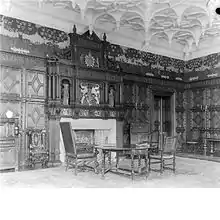Gilling Castle
Gilling Castle is a grade I listed castle near Gilling East, North Yorkshire, England (grid reference SE611768).

History
The castle was originally the home of the Etton family, who appeared there at the end of the 12th century. It was Thomas de Etton who built the fortified manor house in the 14th century – a large tower almost square, whose basement still forms the core of the present building. In 1349 his father had settled the manor of Gilling on his wife's family, the Fairfaxes, in the event of the failure of the Ettons to produce a male heir. Thus, Thomas Fairfax was able to claim the property in 1489, and it was his great-grandson, Sir William Fairfax, who succeeded in 1571, and undertook the rebuilding of the old 14th-century house. Building on top of the medieval walls and leaving the ground floor intact, he rebuilt the first and second floors, adding at the back (east) a staircase turret and an oriel window. The Great Chamber was also built at this time.
At the beginning of the 18th century the owner, now Viscount Fairfax of Emley, remodelled much of the interior of the house and added the wings enclosing the front (west) court. Though this work has often been attributed to John Vanbrugh or James Gibbs,[1] an attribution to the Yorkshire gentleman architect William Wakefield (died 1730), is based on a written note by Francis Drake.[2] Minor alterations were made in the 1750s by John Carr, who was engaged in remodelling the interior of the prominent Fairfax seat in York, Fairfax House, in Castlegate.[3]
On the death of Mrs Barnes (Lavinia Fairfax) in 1885, this branch of the family became extinct and the castle, after passing through several hands, was bought by Ampleforth Abbey in 1929. The vendor, however, retained the panelling and glass of the Great Chamber and sold it separately. The fittings were recovered for Gilling, with the help of the Pilgrim Trust and many friends and subscribers, and restored to its old home in 1952.
Until 2018 the castle was home to St Martin's Ampleforth, the prep school for Ampleforth College. The castle is also designated a Grade I listed building.[4]
The Great Chamber

The Great Chamber is the principal room of the house as rebuilt by Sir William Fairfax, who held Gilling from 1571 to 1597. It survived the 18th century rebuilding almost unaltered and is a remarkable example of the richness and elaboration of a late Elizabethan interior. Sir William was keenly interested to demonstrate in heraldry his connections in Yorkshire, and he used it to decorate the newly built room, to such an extent that in the 1590s, inventories show, there was a book to which visitors could refer in order to identify the arms in plaster, paint and glass.[5] The glass has the signature of a Flemish artist and the date, 1585, which suggests that the room and its decorations were completed that year.
The room is wainscoted in English oak divided in height into three large panels in the four corners. The lozenges are filled with interlacing geometrical patterns in ebony and holly. Each one is different and there are nearly a hundred round the room. Each triangular panel is inlaid with a flower.
The chimneypiece has the Fairfax achievement of arms[6] in the centre panel. Above are the arms of Queen Elizabeth I. The chimney breast above the fireplace has four coats of arms - of Sir William's four sisters and their husbands (Bellasis, Curwen, Vavasour, and Roos, each impaling Fairfax).
Above the wainscoting runs a frieze, painted on boards, displaying the arms of the gentlemen of Yorkshire. They are arranged in twenty-one Wapentakes. To each Wapentake is given a tree and the coats of all gentlemen then living in that district are hung on its branches.
Sir William carried on his heraldic decoration in the painted glass, which is the finest part of the Great Chamber. The south window, which alone survives almost intact, is devoted to the heraldry and genealogy of his second wife's family, the Stapletons. The bay window has suffered, and the first row of lights was reglazed with clear glass, probably in the 18th century. This window shows the story of the Fairfax family. These two windows are the work of Bernard Dininckoff,[7] who has left his signature, with the date 1585 and a tiny portrait of himself, in the bottom right-hand light of the south window. The third (east) window has also lost its lower lights and is by a different artist, slightly later in date. It shows the story of the Constable family. For Sir William's only son, Thomas (afterwards the first Viscount Fairfax), married Catharine Constable of Burton Constable.
The ribbed plaster ceiling with its fans and pendants completed the room. Once again Sir William's enthusiasm for heraldry finds its place, for the grounds of the panels formed by the ribs are decorated with lions (Fairfax coat), and goats and talbots (the Fairfax and Stapleton supporters).
Notes
- Not so attributed in Howard Colvin, A Biographical Dictionary of British Architects, 1600-1840, 3rd ed. 1995.
- "...that worthy gentleman William Wakefield esquire, whose great skill in architecture will always be commended, as long as Duncombe Park and Gilling Castle shall stand", Francis Drake, 1736, quoted in Colvin 1995, s.v. "Wakefield, William".
- Colvin 1995, s.v. "Carr, John".
- Historic England. "Gilling Castle (1149581)". National Heritage List for England. Retrieved 6 June 2019.
- Nicholas Cooper, Houses of the Gentry 1480-1680 1999:320, noting E. Rebecah, "Inventories made for Sir William and Sir Thomas Fairfax," Archaeologia 48 (1885:121-56).
- Fairfax: quarterly of six, Fairfax, Malbis, Etton, Carthorpe, Ergham and Folyfayt.
- ""Doubtless a Fleming or German in origin", he was made a Freeman of York in 1586 (Colvin 1995, s.v. "Dinninghof, Barnard".
External links
| Wikimedia Commons has media related to Gilling Castle. |
- Pictures of England
- Historic England. "Details from listed building database (1149581)". National Heritage List for England.